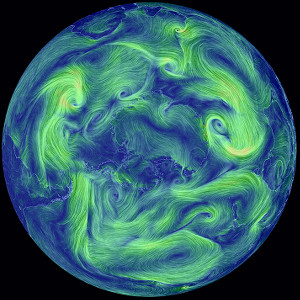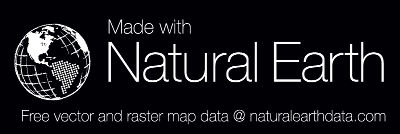a visualization of global weather conditions
forecast by supercomputers
updated every three hours
ocean surface current estimates
updated every five days
ocean surface temperatures and
anomaly from daily average (1981-2011)
updated daily
ocean waves
updated every three hours
 purchase artwork from Point.B Studio to help support this site
purchase artwork from Point.B Studio to help support this site
Community |
Facebook Page
Author |
Cameron Beccario
@cambecc
Free Version of Source |
github.com/cambecc/earth
Modules |
D3.js,
backbone.js,
when.js,
node.js
Weather Data |
GFS (Global Forecast System)
NCEP / National Weather Service / NOAA
Ocean Currents Data |
OSCAR
Earth & Space Research
Sea Surface Temperature |
Real Time Global SST
MMAB / EMC / NCEP
Waves |
WAVEWATCH III
MMAB / EMC / NCEP
Aerosols and Chemistry |
GEOS-5 (Goddard Earth Observing System)
GMAO / NASA
GRIB/NetCDF Decoder |
UCAR/Unidata THREDDS
Geographic Data |
Natural Earth
Hosting |
CloudFlare,
Amazon S3
Font |
M+ FONTS,
Mono Social Icons Font
Color Scales |
chroma.js
ColorBrewer2.org
Kindlmann Linear Luminance
MYCARTA
Dave Green's cubehelix
Waterman Butterfly |
watermanpolyhedron.com
Earlier Work |
Tokyo Wind Map
Inspiration |
HINT.FM wind map
atmospheric pressure corresponds roughly to altitude
several pressure layers are meteorologically interesting
they show data assuming the earth is completely smooth
note: 1 hectopascal (hPa) ≡ 1 millibar (mb)
1000 hPa |
~100 m, near sea level conditions
850 hPa |
~1,500 m,
planetary boundary, low
700 hPa |
~3,500 m, planetary boundary, high
500 hPa |
~5,000 m,
vorticity
250 hPa |
~10,500 m,
jet stream
70 hPa |
~17,500 m,
stratosphere
10 hPa |
~26,500 m, even more stratosphere
the "Surface" layer represents conditions at ground or water level
this layer follows the contours of mountains, valleys, etc.
overlays show another dimension of data using color
some overlays are valid at a specific height
while others are valid for the entire thickness of the atmosphere
Wind |
wind speed at specified height
Temp |
temperature at specified height
TPW (
Total Precipitable Water) |
total amount of water in a column of air
stretching from ground to space
RH |
relative humidity at specified height
WPD (
Wind Power Density) |
measure of power available in the wind
TCW (Total Cloud Water) |
total amount of water in clouds
in a column of air from ground to space
3HPA |
Next 3-hour Precipitation Accumulation:
total amount of precipitation over the next three hours
MSLP (
Mean Sea Level Pressure) |
air pressure reduced to sea level
MI (Misery Index) |
perceived air temperature
combined
heat index and
wind chill
SST (Sea Surface Temp) |
temperature of the ocean surface
SSTA (Sea Surface Temp Anomaly) |
difference in ocean temperature from
daily average during years 1981-2011
Peak Wave Period |
period of most energetic waves,
whether swells or wind generated
HTSGW (
Significant Wave Height) |
roughly equal to mean wave height
as estimated by a "trained observer"
COsc (CO Surface Concentration) |
the fraction of
carbon monoxide present
in air at the earth's surface
CO2sc (CO2 Surface Concentration) |
the fraction of
carbon dioxide present
in air at the earth's surface
SO2sm (Sulfur Dioxide Surface Mass) |
amount of
sulfur dioxide in the air near
the earth's surface
DUext (Dust Extinction) |
the
aerosol optical thickness (AOT) of
light at 550 nm due to
dust
SO4ext (Sulfate Extinction) |
the
aerosol optical thickness (AOT) of
light at 550 nm due to
sulfate
about ocean waves
Significant Wave Height is the average height of the highest 1/3 of waves at a particular point in the ocean. There's a
great writeup here describing what this means.
Peak Wave Period is the (inverse) frequency of the most energetic waves passing through a particular point, whether wind generated or swells. Certainly, there are many more groups of waves moving through an area, each in different directions, but trying to show them all rapidly becomes complex. Instead, we show the one wave group contributing the most energy. This has the effect, though, of creating "boundaries" between regions of ocean where the #1 wave group suddenly switches to second place. Often these boundaries represent swell fronts, but other times they are just artifacts of the ranking mechanism.
about CO2 concentrations
While implementing the visualization of CO2 surface concentration, I noticed the
NASA GEOS-5 model reports a global mean concentration that differs significantly from widely reported numbers. For example, from the run at 2015-11-23 00:00 UTC, the global mean is only 368 ppmv whereas CO2 observatories
report concentrations closer to 400 ppmv. GEOS-5 was constructed in the 2000s, so perhaps the model does not account for accumulation of atmospheric CO2 over time? This is simply speculation. I'm just not certain.
To bring the GEOS-5 results closer to contemporary numbers, I have added a uniform offset of +32 ppmv, increasing the global mean to 400 ppmv. This is not scientifically valid, but it does allow the visualization to become illustrative of the discussion occurring today around atmospheric CO2. Without question, I would welcome a more rigorous approach or an explanation why the GEOS-5 model produces the data that it does.
disclaimer
GEOS-5 data (covering all Chem and Particulates layers) comes with the following
disclaimer:
Forecasts using the GEOS system are experimental and are produced for research purposes only. Use of these forecasts for purposes other than research is not recommended.
about aerosols and extinction
An
aerosol is air containing particles. Common particles are dust, smoke, soot, and water droplets (clouds). These particles affect sunlight primarily through absorption and scattering, which combine to reduce the amount of light reaching the ground. This loss of light as it passes through the atmosphere is called
extinction.
One common measure of extinction is
aerosol optical thickness (AOT), which is (the log of) the ratio between the power of incoming light and the power of transmitted light. This helps us understand how "thick" the air is with particulates.
keyboard shortcuts
e |
show the menu
escape |
close dialog/menu
k |
go forward one time step
shift-k |
go forward eight time steps
j |
go backward one time step
shift-j |
go backward eight time steps
n |
go to now (the most recent data)
i |
go up one pressure level
shift-i |
go up to the stratosphere
m |
go down one pressure level
shift-m |
go down to the surface
g |
toggle the grid on/off
p |
toggle the animation on/off


The GEOS-5 data used on this site have been provided by the Global Modeling and Assimilation Office (GMAO) at NASA Goddard Space Flight Center through the online data portal in the NASA Center for Climate Simulation
weather and ocean data are generated from numerical models
earth.nullschool.net implies no guarantee of accuracy
Copyright (c) 2016 Cameron Beccario

 purchase artwork from Point.B Studio to help support this site
purchase artwork from Point.B Studio to help support this site



